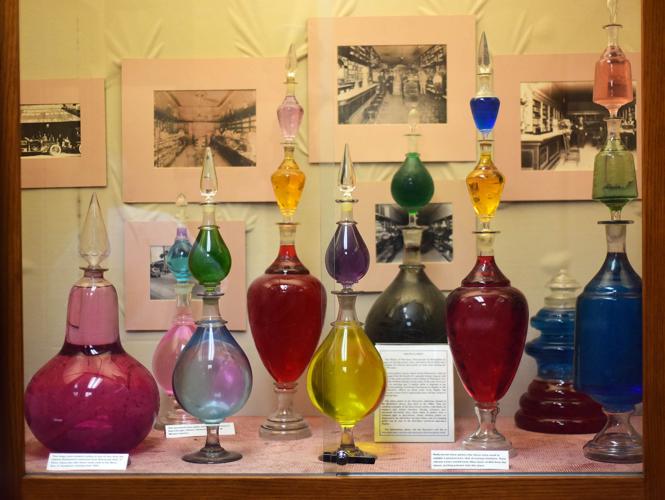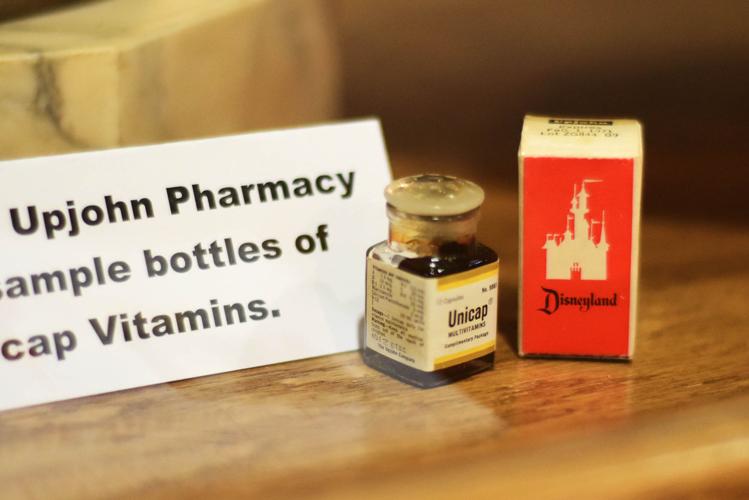A relic from the Ray Drug Store, the front counter, resides on the third stop of the tour at the UA College of Pharmacy Museum.
Richard M. Wiedhopf will celebrate his 50th reunion at the College of Pharmacy this week when the University of Arizona marks its 101st homecoming.
The festivities will include a lunch for the class of 1965 in the Willis R. Brewer Memorial Room — a tribute to the college’s third dean and the youngest, at 33 in 1952, ever appointed dean at UA.
“We all graduated under Dean Brewer so it is kind of special to us,” Wiedhopf said. “He treated the pharmacy kids as his kids.”
Wiedhopf earned his bachelor of science in pharmacy in 1965 and a master of science in pharmacognosy (the study of drugs from natural sources). He’s been the college’s assistant dean for finance and administration since 1978.
Since 1982, he’s also been the curator of the UA’s History of Pharmacy Museum, which exists throughout the College of Pharmacy complex.
In addition to taking creative advantage of available space, Wiedhopf said the multiple locations expose more students to the museum’s extensive collections of donated artifacts, artworks and books.
The Brewer room is the fifth stop on a self-guided museum tour that is open to the public. A photo tour is offered online at pharmacy.arizona.edu (click on “visitors”).
With the Brewer room, Wiedhopf transformed a space once used for storage on the first floor of the Skaggs Pharmaceutical Sciences Center into a replica of a late 19th or early 20th century pharmacy so complete that walking through the door feels stepping back in time. There’s a checkered tile floor, authentic store fixtures, and massive wooden display cabinets filled with items. “It’s an eclectic collection,” Wiedhopf said.
Jesse Hurlbut, a former Tucson pharmacist and state pharmacy board inspector, and his wife, Mary, are credited with giving the museum its start. He collected the initial items from throughout the Southwest that led to the museum’s creation in 1966 in the old pharmacy/microbiology building on the UA main campus.
George A. Bender, who taught a course on the history of pharmacy, curated the museum from the late ’60s to the late ’70s as the college prepared to move from the main campus to the health sciences complex
“He was a world famous historian on the topic of pharmacy,” Wiedhopf said.
In 1982 the collection moved to the College of Pharmacy building (now the Skaggs Pharmaceutical Sciences Center). Wiedhopf devised a way to move the massive Ray Drug case, using a crane, onto the building’s second floor.
Wiedhopf also installed the bright yellow and black tiles salvaged from the Winslow Drug Store next to the Ray Drug case.
Most of the items on display date to the 1800s while Arizona was still a territory through the 1950s. The tour brochure notes that “while most medications today are sold as pre-manufactured pills, prescriptions in territorial days were often compounded from plant materials.”
This point is driven home by a 102-drawer cabinet filled with natural products at the tour’s seventh stop, which is on the fourth floor of the Skaggs building right as you get off the elevator.
The museum also includes a wide range of cosmetics, camera supplies, hair dye, and pens and pencils among other non-pharmaceutical items that drug stores routinely carried.
“They were a gathering place,” said Wiedhopf, pointing to a 10-gallon ice cream maker from Winslow that still works.
One offbeat item is a small jar that holds used Blackjack chewing gum that an “Eastern dude” stashed under the counter at the Owl Drug Store downtown while waiting for lunch, Wiedhopf said. The pharmacist — Jesse Hurlbut — later realized the gum chewer had been John Dillinger in the days leading up to his capture.
Generations of pharmacy alumni and their families have donated — and continue to donate — items to the museum knowing their historical value.
Some artifacts, such as show globes, which according to the tour were items “used by apothecaries during the Great Plague of London in 1665 to direct the sick to their shop” are also highly collectible to investors.
Some Tucsonans may be surprised to learn that the Upjohn pharmacy display was part of Main Street, USA when Disneyland opened in 1955 through 1970. That donation included nearly 900 pieces, including a series of leaded glass lamps that were recently installed and lit on the third floor of Drachman Hall.
Another large donation arrived in March, when the family of alumnus Bob Thomas (who in 1950 was part of the college’s first graduating class) donated antique pharmacy items found in the basement of a Rexall Drug Store he’d acquired in Illinois in the 1960s.
“Pharmacists are collectors,” Wiedhopf said, estimating there may be as many as 500,000 donated items still packed away. Opening every box is an adventure, and Wiedhopf works through the donated items as he has time.
He’s had help the last few years.
“I figure if you do a little bit every day it will get done,” said Stephen Hall, the museum’s first assistant curator.
This is a dream job for Hall, who grew up in the Phoenix area and has wanted to be a curator since he visited the Smithsonian when he was 14. “I decided to work toward it ever since,” said Hall, who was still an undergraduate when he called Wiedhopf and asked if he could volunteer.
“Nobody had ever asked me that,’ said Wiedhopf, who extended the job offer once Hall earned his master’s from the UA’s School of Information Resources and Library Science.
While the tour can be self-guided with brochures, Hall estimates he’s given 30 to 40 tours so far. Wiedhopf has given hundreds.
Wiedhopf sees a bright future for the museum. “This is the history of Arizona pharmacy and a lot more. It’s great for a profession to see where it came from.”














